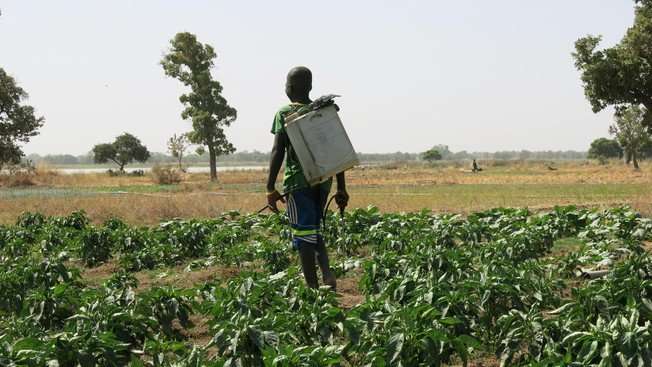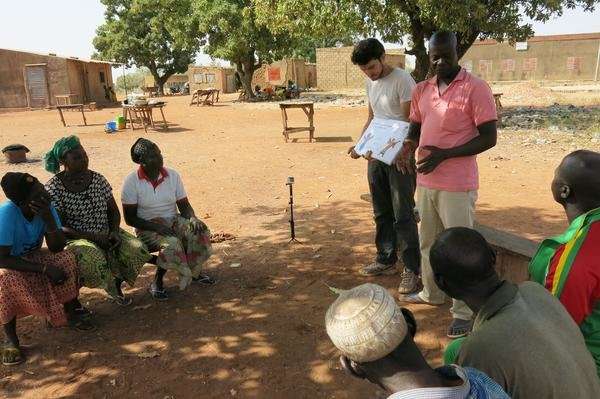Confirming the risks of pesticide use in Burkina Faso

Poor pesticide practices in Burkina Faso pose a threat to human health and the environment. An EPFL thesis has quantified this problem for the first time through an analysis of soil, water, sediment, vegetable and hair samples.
Small-scale vegetable growers in Burkina Faso are unfamiliar with the proper use of pesticides and end up exposing both people and the environment to serious contamination risks. The quantity of pesticide applied to a given surface area is higher than the recommended level in 72 percent of cases, while the recommended spray concentration is exceeded 56 percent of the time. As a result, the water in around 30 percent of the wells in agricultural areas is unsuitable for drinking, and the pesticide level in 36 percent of vegetables does not meet international regulatory standards. The concentration of endocrine disrupters and the presence of carcinogens represent a particular risk to humans – especially children.
These are the main findings of Edouard Lehmann's thesis in the field of environmental sciences and engineering. His work represents the first time that the overall impact of pesticide use by Burkina Faso market gardeners and its environmental and health risks have been quantified through a careful analysis of soil, water, sediment, vegetable and hair samples. Thanks to this broad approach, Lehmann was able to come up with a number of recommendations aimed at reducing pesticide contamination in the future.
Burkina Faso is a priority country for the Swiss Agency for Development and Cooperation, which funded Lehmann's thesis. Around 90 percent of the country's inhabitants depend on subsistence farming, although it is noteworthy that pesticide use is modest in comparison with other countries. However, past studies revealed that 70–80 percent of farmers experienced health problems while and just after applying pesticides. Until now, no quantitative study had ever looked into the origin of these health problems or identified the extent of the environmental contamination caused by the farmers. "This research doesn't have just health and environmental implications, but economic ones too," says Lehmann, who completed his thesis at EPFL's Central Environmental Laboratory (CEL). "Burkina Faso's government sees vegetable exports as one way of revitalizing its rural areas. But if the vegetables fail to meet international standards, they can't be exported."
Lehmann successfully defended his thesis at the end of 2017. The aim of his research was to develop analytical methods that would be suitable for the region and that could be used by key actors in the sector. Lehmann therefore worked closely with the laboratory at the International institute for water and environmental engineering (2iE) in Ouagadougou to bolster their analytical capacities. He took the QuEChERS (Quick, Easy, Cheap, Effective, Rugged, and Safe) method, which had already been used to analyze pesticide residues in vegetables, and applied it to hair for the first time. Unlike other methods, QuEChERS requires little in the way of equipment, solvents and laboratory infrastructure. This makes it well suited for use in developing countries. One obstacle that took some time to overcome was the actual taking of hair samples, which is often associated with black magic.
Unsafe agricultural practices
In the first part of his thesis, Lehmann analyzed the agricultural practices of 540 market gardeners in four locations in central Burkina Faso. The lack of personal protective equipment was alarming – the farmers were often dressed only in shorts and t-shirts when treating crops. They were also unaware of the appropriate application periods, which meant the pesticide treatments tended to be haphazard.

Who's to blame? One possible answer can be found on the labels of the products sold, which are often incomplete or in a foreign language – or nonexistent. What's more, the illiteracy rate is high, and vendors often lack training on the appropriate use of the products they sell. As a result, it is common practice for the farmers to combine pesticides, as Lehmann notes: "Some farmers mix the products they buy at the market and taste them, saying that the more it stings, the better it will work against parasites." Managing waste, which consists mainly of pesticide packaging, is also a problem when crops are near lakes or rivers. That was the case at one of the sites near Lake Loumbila, which provides 30 percent of the drinking water to the country's capital, Ouagadougou.
Banned pesticides
Comparing data collected over three years, Lehmann identified seasonal variations in pesticide contamination. This led to an unsettling observation: "During the rainy season every year, we detected higher levels of pesticides in Lake Loumbila, some of which were banned under the Stockholm Convention, which Burkina Faso ratified." These banned pesticides, referred to as POPs (persistent organic pollutants), are considered a serious threat to human health and the environment. The study also looked at the quality of drinking water from wells and boreholes. Results revealed that whereas groundwater was uncontaminated by pesticides, water from 30 percent of traditional wells dug in the fields was unfit for drinking.
The findings were also troubling when it comes to vegetable production: 36 percent of the approximately 100 vegetables analyzed exceeded "maximum residue limits," an international exportation standard. Questionnaires on dietary intake were then sent to 120 people to assess their exposure to pesticides. According to the results, 19 percent of children faced acute risks from dietary exposure, while 17 percent faced chronic risks. For adults, 6 percent of cases presented acute risks, while 4 percent were at chronic risk.
Recommendations and next steps
Overall, out of 45 pesticides that were screened, 38 were detected. For the health situation to improve, people's exposure to pesticides must therefore be reduced. "Better prevention and simple protective measures applied on a daily basis would go a long way towards lowering risk levels," said Lehmann. His study concludes by proposing an action plan to raise awareness at the regional, national and international levels. His recommendations include no longer drinking water from wells in the fields, respecting a minimum distance between the lake and crops, rinsing vegetables with water before eating them, covering both hands and body when applying pesticides, and keeping children away from fields that are being treated. Lehmann also emphasized the need for a countrywide ban on three substances and for better training for pesticide vendors.
Supported by researchers from 2iE, Lehmann delivered his recommendations in December to the people living in the regions he studied and to the authorities. "The villagers were very receptive and appeared keen to improve their practices, especially after learning that the main victims of pesticide contamination are children."
Lehmann envisions several future directions for his research, including similar studies in countries bordering Burkina Faso and an in-depth analysis into POPs in Lake Loumbila's waters.
More information: Impact Assessment of Pesticides Applied in Vegetable-Producing Areas in the Saharan Zone the Case of Burkina Faso. DOI: 10.5075/epfl-thesis-8167 , infoscience.epfl.ch/record/233605?ln=fr
Provided by Ecole Polytechnique Federale de Lausanne




















